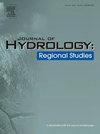Runoff simulation of the Kaidu River Basin based on the GR4J-6 and GR4J-6-LSTM models
IF 5
2区 地球科学
Q1 WATER RESOURCES
引用次数: 0
Abstract
Study region
The Kaidu River Basin originates from the southern slope of the Tienshan Mountains in the Xinjiang Uygur Autonomous Region, China.
Study focus
Accurate runoff simulation and prediction significantly affect flood control, drought resilience, and water resource allocation decisions. This study establishes the GR4J-6 model (modèle du Génie Rural à 4 paramètres Journalier-6, including a snowmelt module) and integrates it with the LSTM (Long Short-Term Memory) model to construct the hybrid GR4J-6-LSTM model and enhance the simulation accuracy of snowmelt runoff. A case study is conducted in the Kaidu River Basin to demonstrate the applicability of these models in cold and arid regions. The accuracy of the GR4J-6, LSTM, and GR4J-6-LSTM models is evaluated using Nash-Sutcliffe efficiency (NSE), Kling-Gupta Efficiency (KGE), and Root Mean Squared Error (RMSE) metrics. In addition, the contributions of each feature variable in the models are analyzed using the SHapley Additive exPlanations (SHAP) method to enhance the reliability of the results.
New hydrological insights for the region
The GR4J-6 model demonstrated good applicability in the Kaidu River Basin, with NSE, KGE, and RMSE values of 0.69, 0.79, and 39.39 m3/s during the validation period, respectively. The hybrid model GR4J-6-LSTM exhibited the highest comprehensive accuracy among all the models, with NSE, KGE, and RMSE values of 0.84, 0.87, and 28.79 m3/s, respectively. In the LSTM model, temperature and precipitation were found to significantly influence the simulated runoff, indicating that higher temperature and precipitation lead to increased runoff. In the GR4J-6-LSTM model, Tmin (minimum temperature) and the hydrological feature variable Qsim exhibited a strong positive correlation with simulated runoff, as Tmin and Qsim increased, they promoted stronger flow production. This study provides a framework for runoff simulation in snowmelt river basins, offering a reference for projecting extreme hydrological events under climate change.
基于 GR4J-6 和 GR4J-6-LSTM 模型的开都河流域径流模拟
研究区域开都河流域发源于中国新疆维吾尔自治区天山南坡。研究重点准确的径流模拟和预测对防洪、抗旱和水资源分配决策具有重要影响。本研究建立了 GR4J-6 模型(modèle du Génie Rural à 4 paramètres Journalier-6,包括融雪模块),并将其与 LSTM(Long Short-Term Memory)模型相结合,构建了 GR4J-6-LSTM 混合模型,提高了融雪径流的模拟精度。在开都河流域进行的案例研究证明了这些模型在寒冷干旱地区的适用性。使用 Nash-Sutcliffe 效率(NSE)、Kling-Gupta 效率(KGE)和均方根误差(RMSE)指标评估了 GR4J-6、LSTM 和 GR4J-6-LSTM 模型的精度。GR4J-6 模型在验证期间的 NSE、KGE 和 RMSE 值分别为 0.69、0.79 和 39.39 立方米/秒,在开都河流域表现出良好的适用性。在所有模型中,混合模型 GR4J-6-LSTM 的综合精度最高,NSE、KGE 和 RMSE 值分别为 0.84、0.87 和 28.79 m3/s。在 LSTM 模型中,温度和降水对模拟径流有显著影响,表明温度和降水越高,径流越大。在 GR4J-6-LSTM 模型中,Tmin(最低气温)和水文特征变量 Qsim 与模拟径流呈强正相关,随着 Tmin 和 Qsim 的增加,它们会促进更强的流量产生。这项研究为融雪河流域的径流模拟提供了一个框架,为预测气候变化下的极端水文事件提供了参考。
本文章由计算机程序翻译,如有差异,请以英文原文为准。
求助全文
约1分钟内获得全文
求助全文
来源期刊

Journal of Hydrology-Regional Studies
Earth and Planetary Sciences-Earth and Planetary Sciences (miscellaneous)
CiteScore
6.70
自引率
8.50%
发文量
284
审稿时长
60 days
期刊介绍:
Journal of Hydrology: Regional Studies publishes original research papers enhancing the science of hydrology and aiming at region-specific problems, past and future conditions, analysis, review and solutions. The journal particularly welcomes research papers that deliver new insights into region-specific hydrological processes and responses to changing conditions, as well as contributions that incorporate interdisciplinarity and translational science.
 求助内容:
求助内容: 应助结果提醒方式:
应助结果提醒方式:


